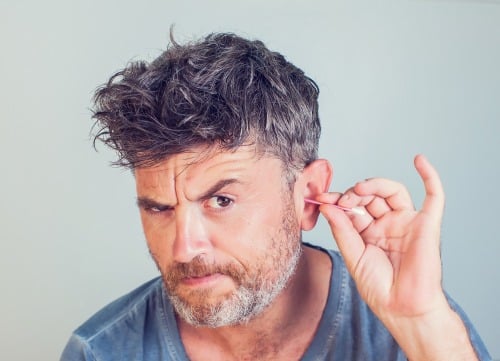Truth About Earwax Removal

Digging it out with cotton swabs isn’t the solution. What to do instead.
If you’re like many people, you might reach for a cotton swab when you feel as though wax has built up in your ears, even if you’ve heard that these little tools aren’t so helpful. When it comes to removing earwax, cotton swabs may even do more damage than good. It’s a big problem for such a little device! However, other options exist.
While earwax, also known as cerumen, can pose problems if it builds up and becomes impacted, it does serve a purpose, and ardent ear cleaners may not understand this. Small doses of earwax are beneficial and protects your hearing. Earwax can be both sticky or crumbly and dry. Its function is to trap debris such as dust or skin from getting into your ear canal as well as keeping the ear canal moisturized. Earwax can even kill bacteria! It should naturally migrate from the inner ear outward without causing much of an issue.
Buildup, however, can lead to discomfort, dizziness, itching, and unexpected symptoms such as coughing. It can also make it difficult to hear or cause ringing of the ears, also known as tinnitus. Buildup becomes more common as people age; it’s a big issue with the elderly because earwax becomes drier and less mobile. Hearing aids can also lead to earwax buildup. However, some people seem genetically predisposed to excessive earwax.
But buildup doesn’t mean that you should reach for a cotton swab! Swabs can perforate the eardrum an even push earwax further into the ear canal, which can lead to impaction.
Safe Ways to Clean Your Ears at Home
Instead, consider over-the-counter drops that soften the earwax so it can naturally work itself our of your ear. Irrigation kits are also an option. They include a bulb or syringe that squirts eardrops into the ears to flush out earwax. These options may not be ideal for anyone who has had ear surgery or a perforated eardrum, however.
When it comes to earwax removal, you should avoid cotton swabs and ear candling. The latter is a practice that has become more common. It involves inserting a tube into the ear and lighting a fire on the other end to draw out earwax via suction. However, these devices have been proven to be ineffective, and fire that close to your body can cause injury. The FDA has even spoken out about ear candling because of these risks!
When eardrops and irrigation fail to remove earwax or buildup has become a problem, it may be time to talk to a professional. Ear, nose, and throat doctors can treat a variety of ear issues, including wax buildup, infections, hearing loss, and tinnitus. Correcting these problems before they worsen may be crucial to preserving your hearing function.






